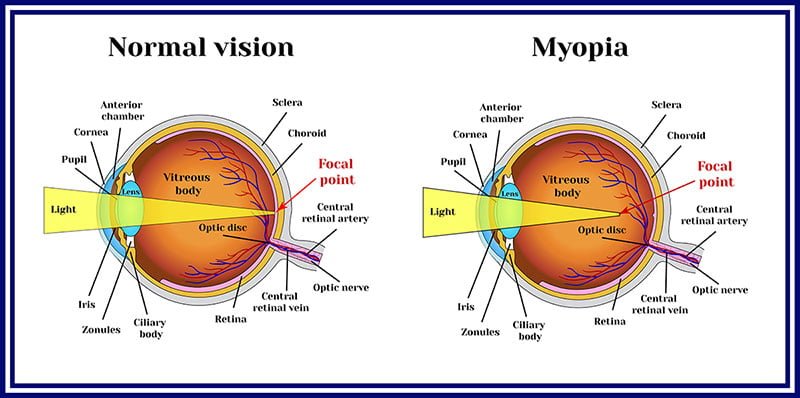Symptoms and causes

Myopia, or myopia, is the most common cause of low vision in humans these days. Usually it does not lead to complete blindness, but it can make daily activities much more difficult. The need to use glasses or contact lenses to “see something” is unlikely to please anyone.
A brief excursion into ophthalmic optics. Rays of light entering the eye can be focused to the retina when the cornea and the lens are excessively distorted. This condition is called myopia, or nearsightedness, in ophthalmology. Under ideal conditions, when the optical structures are working properly, the image is focused as clearly as possible on the retina – and the eye sees well. This condition is called emmetropia. The third variant is when the cornea and lens do too little work, and the rays of light do not have time to assemble into a clear picture on the retina. This is hyperopia, or farsightedness.
Now you can understand why a person sees poorly with myopia: a mismatch between the power of the optics and the size of the eyeball, in which light rays form an image before they reach the retina. And when they reach the retina, the image becomes blurred again.
Unfortunately, no one in the world has been able to find the cause of myopia. It is likely that the problem is not caused by a single factor, but it includes a variety of different factors that are unrelated at first glance. For example, it is believed that high visual stress, spending little time outdoors, and myopia in parents may contribute to the appearance of myopia in children.
Usually the progression of myopia is detected during the first two decades of life. This is due to the fact that the main growth of the eye occurs in this period. Currently there is no effective method for completely stopping the growth of the eye.
Myopia and myopia treatment
Nevertheless, not everything is so hopeless for a person with myopia. There are several methods of correcting it. They can be divided into temporary and permanent. The first include glasses and various types of contact lenses. They improve vision without anatomically changing anything in the eye. This is possible due to the additional optical effect of the spectacle or contact lens on the course of light rays entering the eye. Thus, the best image in terms of clarity is formed in the right place, that is, on the retina. But their effect is temporary, because once you remove your glasses or contact lenses, your poor vision immediately returns.
Laser correction and intraocular lens exchange are a permanent method of myopia correction. After these procedures, no glasses or lenses are necessary, and the vision is restored to its maximum potential. The effect of these interventions usually lasts for the rest of your life.
A short excursion into ophthalmic optics. Rays of light entering the eye can be focused to the retina when the cornea and lens are excessively altered in their course. This condition is called myopia, or nearsightedness, in ophthalmology. Under ideal conditions, when the optical structures are working properly, the image is focused as clearly as possible on the retina – and the eye sees well. This condition is called emmetropia. The third variant is when the cornea and lens do too little work, and the rays of light do not have time to assemble into a clear picture on the retina. This is hyperopia, or farsightedness.
Now you can understand why a person sees poorly with myopia: a mismatch between the power of the optics and the size of the eyeball, in which light rays form an image before they reach the retina. And when they reach the retina, the image becomes blurred again.
Unfortunately, no one in the world has been able to find the cause of myopia. It is likely that the problem is not caused by a single factor, but it includes a variety of different factors that are unrelated at first glance. For example, it is believed that high visual stress, spending little time outdoors, and myopia in parents may contribute to the appearance of myopia in children.
Usually the progression of myopia is detected during the first two decades of life. This is due to the fact that the main growth of the eye occurs in this period. Currently, there are no effective methods for completely stopping the growth of the eye.

Laser vision correction
Although glasses and contact lenses help with myopia, they can be compared to a cast and crutches, that is, it is a temporary solution to get out of the situation, but it does not actually eliminate the cause of the problem the way surgery does.
The most common of the treatment options for myopia is laser vision correction. Our equipment and methods have already proven to be effective and safe in correcting all known refractive anomalies in the world.
Intraocular correction
In some cases, implantation of an intraocular lens (IOL) to replace the lens is the treatment of choice for astigmatism.
- Monofocal lenses
- Multifocal lenses
The technologies we have at our disposal allow us to solve “hopeless” cases when a patient has been rejected by other clinics.
Having such a great technological arsenal and experience we can surely say that we are able to solve practically any clinical myopia case within the shortest period of time. Our doctors will select the most suitable variant of treatment and perform the necessary surgical treatment successfully.
Intraocular lenses are suitable for the correction of high myopia. If laser correction is not for you, do not give up since there are other possibilities for the achievement of your goals. “
“British Ophthalmological Center” offers a number of surgeries that can help you. During the consultation we will be able to find out if surgery is contraindicated for you and determine the best surgery option for you.